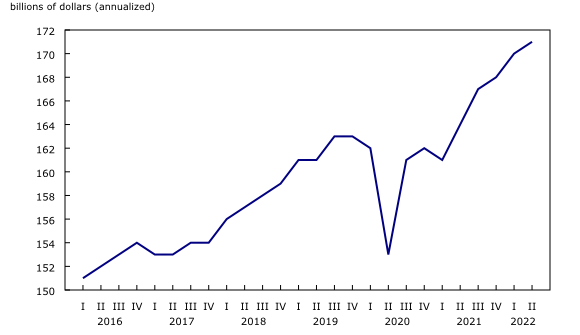Non-profit institutions and volunteering: Economic contribution, second quarter 2022
Archived Content
Information identified as archived is provided for reference, research or recordkeeping purposes. It is not subject to the Government of Canada Web Standards and has not been altered or updated since it was archived. Please "contact us" to request a format other than those available.
Released: 2022-10-03
Real gross domestic product of non-profit institutions increases for the fifth consecutive quarter
Real gross domestic product (GDP) of non-profit institutions rose 1.0% in the second quarter, the fifth consecutive quarterly increase, led by non-profit institutions serving businesses. By comparison, the economy-wide real GDP increased 0.8% in the second quarter, driven by business investment in inventories, non-residential structures and machinery and equipment.
Non-profit institutions serving businesses lead the increase
Non-profit institutions serving businesses' real GDP grew 3.1% in the second quarter, the fifth consecutive quarterly increase. Growth was led by the resumption of operations of non-essential businesses, as the government lifted restrictions aimed at limiting the spread of the Omicron COVID-19 variant.
Non-profit institutions serving households recorded a real GDP increase of 2.0%, following a 0.5% increase in the first quarter. Non-profit institutions serving households continued to follow a trend similar to non-profits serving businesses with the lifting of pandemic-related restrictions on production and consumption.
Real GDP of non-profit institutions serving governments rose 0.5%, the fifth consecutive quarterly increase. Growth was driven by the gradual resumptions of school operations to their pre-pandemic state.
Widespread increases in non-profit employment
Employment (+0.9%) rose throughout non-profit institutions in the second quarter, led by social services (+2.3%), education and research (+1.0%) and business and professional associations and unions (+3.1%). Health care (-0.1%) recorded the lone decrease in employment activities, as hospitals continued to experience a shortage of health care workers.
Jobs in social services rose 2.3%, a seventh increase in eight quarters. Employment in social services was greatly impacted early in the pandemic, as many organizations faced restructuring due to budgetary constraints.
Employment in education and research activities grew 1.0%, the largest quarterly increase since the fourth quarter of 2020.
Business and professional associations and unions increased their number of jobs by 3.1% in the second quarter of 2022, the first increase since the second quarter of 2021. This increase aligned with non-essential businesses resuming normal activities after the lifting of restrictions aimed at limiting the spread of the Omicron COVID-19 variant.
Nominal gross domestic product rises
Non-profit institutions' nominal GDP rose 1.4% in the second quarter, the eighth consecutive quarterly increase, owing to increases in prices and real GDP in the quarter. Increases were broad-based and were seen in the following activities: education and research (+1.9%), social services (+3.3%), business and professional associations and unions (+3.1%) and development and housing (+5.8%).
For non-profit institutions, excluding those serving governments, nominal GDP grew 3.7% in the second quarter, following a 1.7% increase in the first quarter.
Overall, non-profit institutions represented 8.1% of economy-wide nominal GDP in the second quarter, down from 8.3% in the first quarter.
Note to readers
With this release, data have been revised for the first quarter of 2022 due to the incorporation of updated source data and seasonal adjustment. Moreover, the government non-profit GDP (2012 constant prices) estimates have been revised since the first quarter of 2009; the impact on the overall non-profit GDP (2012 constant prices) was minimal.
The non-profit indicators are quarterly indicators for the main aggregates in the Satellite Account of Non-profit Institutions and Volunteering, namely gross domestic product, output and employment. The estimates from this account are directly comparable with the estimates in the Canadian System of Macroeconomic Accounts.
For the purposes of these estimates, the definition of the non-profit sector adheres to international standards published in the United Nations' Satellite Account on Non-profit and Related Institutions and Volunteer Work. Canada's overall non-profit sector is divided into the following three broad categories:
Community non-profit institutions include organizations engaged, for example, in social services, advocacy, or sports and recreation. These make up the "non-profit institutions serving households" sector in standard macroeconomic measures.
Business non-profit institutions include, for example, business associations, chambers of commerce and condominium associations. These are classified to the business sector in standard measures.
Government non-profit institutions include hospitals, some residential care facilities, universities and colleges. These are classified to the government sector in standard measures.
Products
The data visualization product "Quarterly Non-Profit Institutions Economic Account: Interactive tool," which is part of Statistics Canada – Data Visualization Products (71-607-X), is available.
As a complement to this release, the data visualization product "Annual Non-Profit Institutions Human Resource Module: Interactive tool," which is part of Statistics Canada – Data Visualization Products (71-607-X), is available.
The document "An overview of the Non-Profit Sector in Canada: 2010 to 2020," which is part of Latest Developments in the Canadian Economic Accounts (13-605-X), is available.
The Economic accounts statistics portal, accessible from the Subjects module of the Statistics Canada website, features an up-to-date portrait of national and provincial economies and their structure.
The Latest Developments in the Canadian Economic Accounts (13-605-X) is available.
The User Guide: Canadian System of Macroeconomic Accounts (13-606-G) is available.
The Methodological Guide: Canadian System of Macroeconomic Accounts (13-607-X) is available.
Contact information
For more information, or to enquire about the concepts, methods or data quality of this release, contact us (toll-free 1-800-263-1136; 514-283-8300; infostats@statcan.gc.ca) or Media Relations (statcan.mediahotline-ligneinfomedias.statcan@statcan.gc.ca).
- Date modified:





